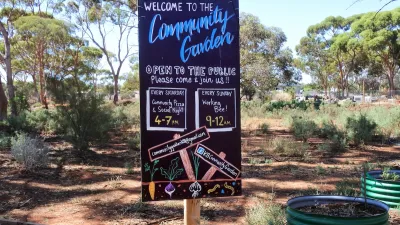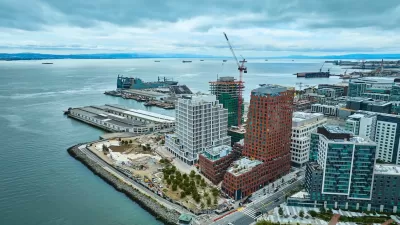Public art can be personal, political, grandly scaled, or small in ambition. And, yes, there's a "new wave" of public art to be found in yard bombing, flash mobs, and tactical urbanism. Find out what the experts say about the future of public art.
Artsblog just completed a weeklong blogging salon on the future of Public Art. Patricia Walsh sums up some of the posts with a mention of the need for more planners who are willing to support public art: "Reading these posts throughout the week has given light to some of the great talent that will be guiding the future of public art. We heard from Kati Stegall reflecting on how we can keep up with the changes happening throughout the country and from Meredith Frazier Britt, an up-and-coming city planner who is eager to work with public art (we need more of her!)"
The salon includes 13 more posts that examines local case studies as well as higher-elevation discussions of national trends.
FULL STORY: Round-up for Aspirations and Reflections: Emerging Leaders in Public Art Administration

Manufactured Crisis: Losing the Nation’s Largest Source of Unsubsidized Affordable Housing
Manufactured housing communities have long been an affordable housing option for millions of people living in the U.S., but that affordability is disappearing rapidly. How did we get here?

Americans May Be Stuck — But Why?
Americans are moving a lot less than they once did, and that is a problem. While Yoni Applebaum, in his highly-publicized article Stuck, gets the reasons badly wrong, it's still important to ask: why are we moving so much less than before?

Using Old Oil and Gas Wells for Green Energy Storage
Penn State researchers have found that repurposing abandoned oil and gas wells for geothermal-assisted compressed-air energy storage can boost efficiency, reduce environmental risks, and support clean energy and job transitions.

Updating LA’s Tree Rules Could Bring More Shade to Underserved Neighborhoods
A new USC study finds that relaxing Los Angeles’ outdated tree planting guidelines could significantly expand urban tree canopy and reduce shade disparities in lower-income neighborhoods, though infrastructure investments are also needed.

California's Canal Solar Projects Aim to Conserve Resources and Expand Clean Energy
California’s Project Nexus has begun generating electricity from solar panels installed over irrigation canals, with researchers and state agencies exploring statewide expansion to conserve water and boost clean energy production.

HHS Staff Cuts Gut Energy Assistance Program
The full staff of a federal program that distributes heating and cooling assistance for low-income families was laid off, jeopardizing the program’s operations.
Urban Design for Planners 1: Software Tools
This six-course series explores essential urban design concepts using open source software and equips planners with the tools they need to participate fully in the urban design process.
Planning for Universal Design
Learn the tools for implementing Universal Design in planning regulations.
Heyer Gruel & Associates PA
City of Moreno Valley
Institute for Housing and Urban Development Studies (IHS)
City of Grandview
Harvard GSD Executive Education
Salt Lake City
NYU Wagner Graduate School of Public Service
City of Cambridge, Maryland





























